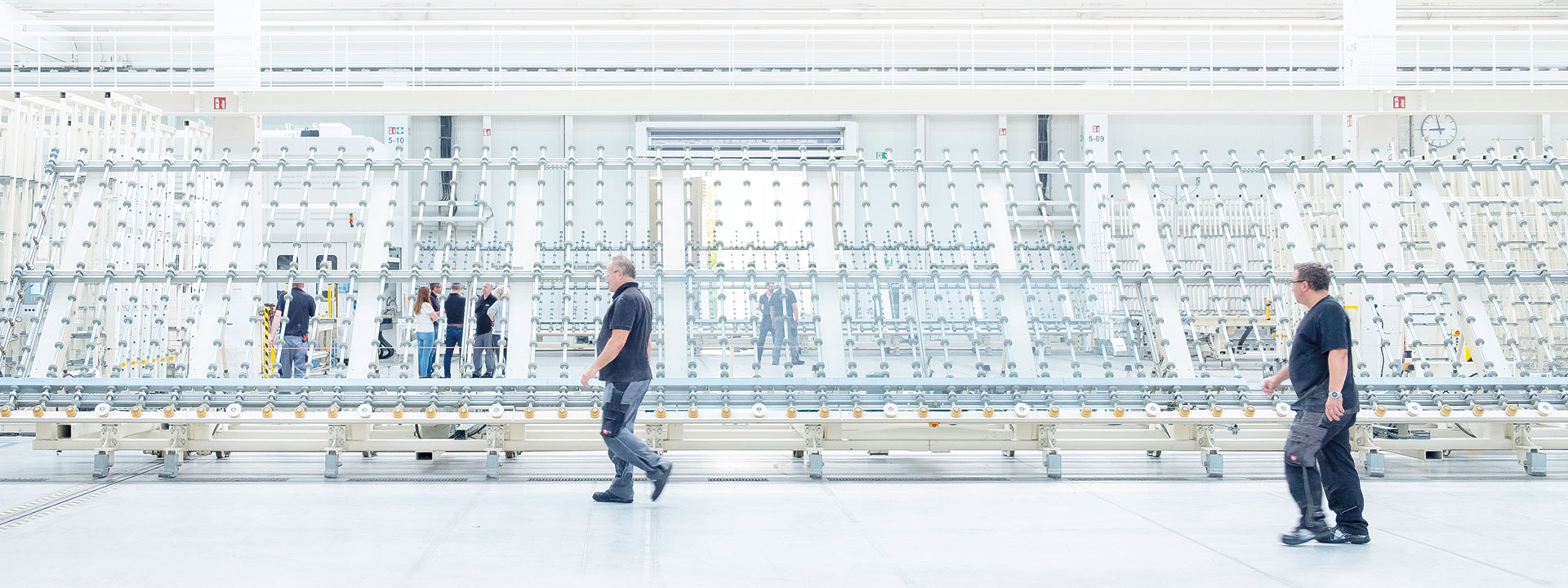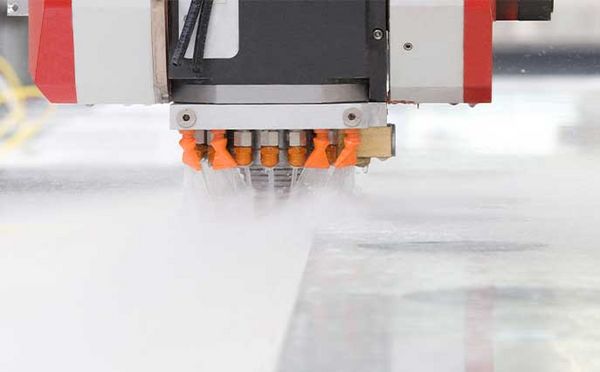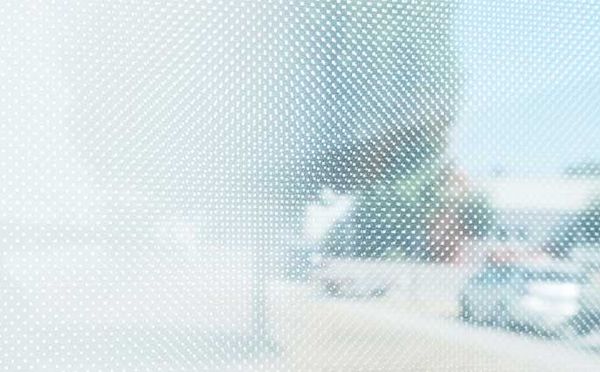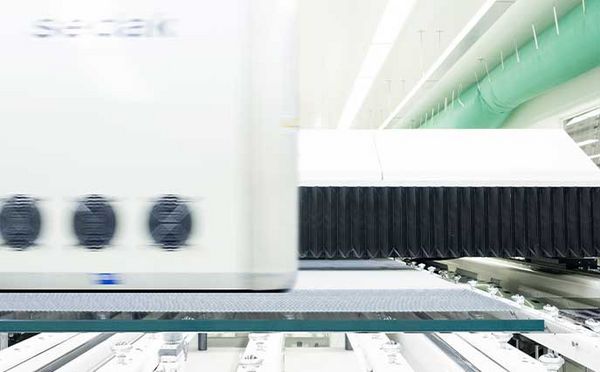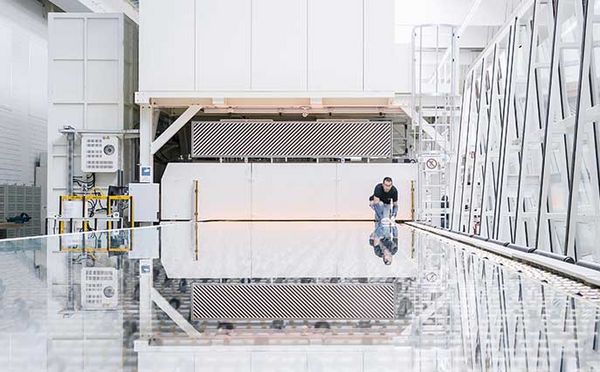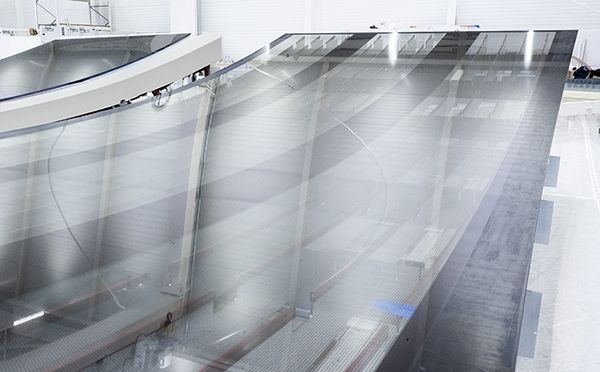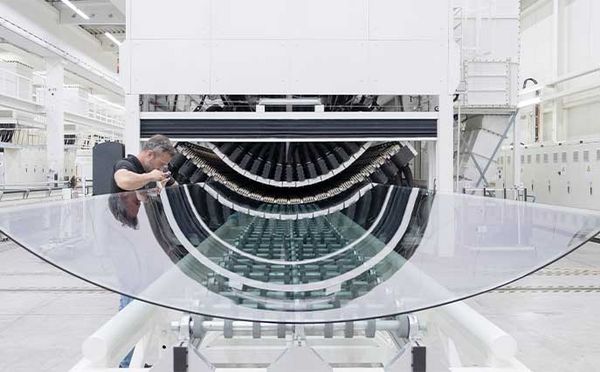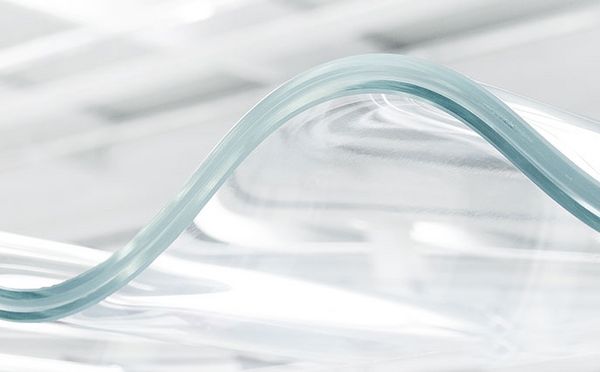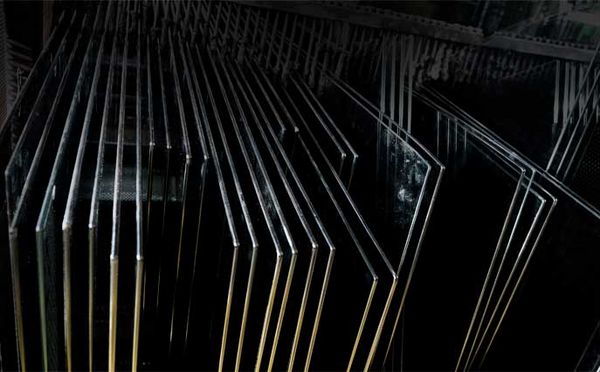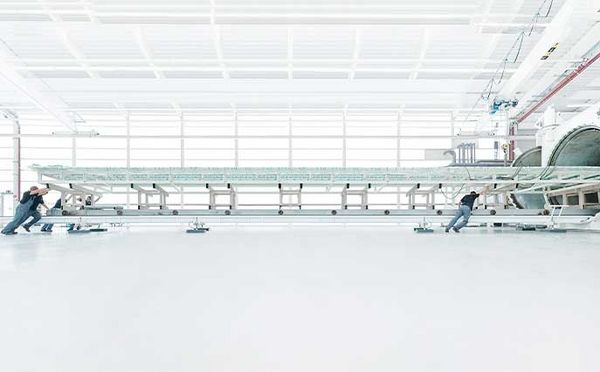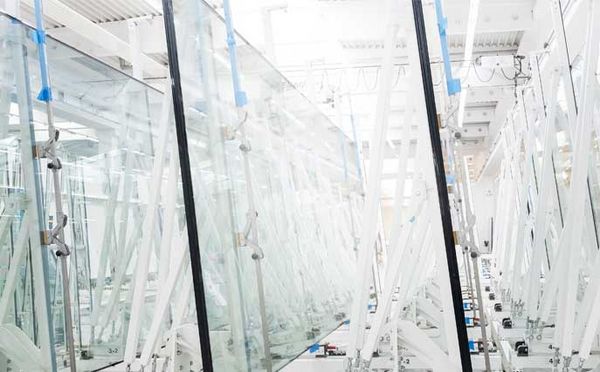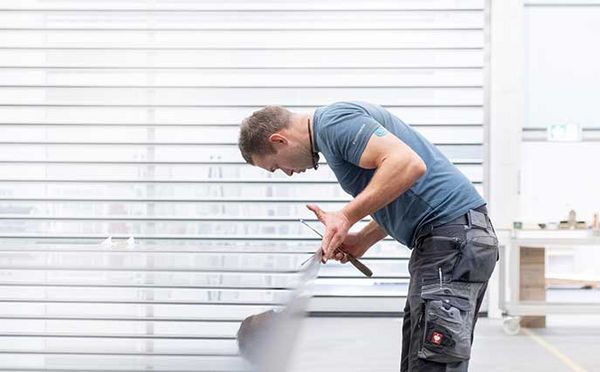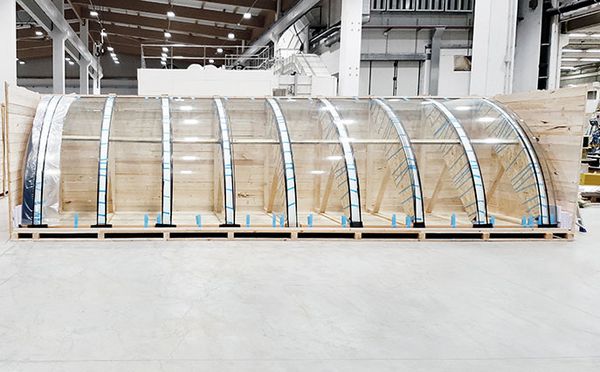the future of glass is a development by sedak
Our production operations are conducted with the utmost precision, facilitated by the largest and most cutting-edge collection of machinery for glass processing. Equipped with advanced high-tech machines, modern tempering furnaces and computer-controlled processes, we uphold the highest standards in the industry.
Our machines are designed for oversized formats (max. 3.6m x 20m | 787in) and complex glass products. Thanks to this enormous production capacity, we can realize even the most demanding visions. Thus, sedak produces glass products of the highest quality for architecture, marine, and railway.
Behind the state-of-the-art machinery is the expertise of qualified sedak employees. Their expertise, knowledge, and intuitive craftsmanship complement advanced technology and ensure that every glass product we manufacture meets the highest standards of quality and craftsmanship.
Glass processing is what sedak is all about, and, more precisely, in sizes of up to 20m (787in). Our computer-controlled machining centers handle grinding, drilling, and milling of basic glass products with lengths matching the scale. sedak edging is accurate, even on large panes, and with a much higher quality than required by the DIN standard. Uncompromising dimensional accuracy also applies to the drilling and milling. The precision tooling at sedak enables mechanical processing of glass in its final shape.
cutting | edging | cut-outs | drilling | milling | groove grinding
sedak is a pioneer in processing coated glass, e.g., for efficient solar control and low-e glasses, must also satisfy our stringent quality criteria. sedak, in cooperation with its partners, can offer the whole range of high-quality coatings. We can also provide various decorative coatings, also in real gold (24 carat) and silver, for example, upon request.
solar | low-e | high-selectivity | decorative patterns | gold & silver
Large-format, UV-resistant printing on glass up to 20m opens up a new world of individual glass design - made by sedak. sedak uses two methods based on ceramic inks for vivid, hardwearing printing on glass, i.e., roller-coater printing for full-coverage, single-color applications, and digital printing. After applying the ceramic inks, they are fired at temperatures exceeding 600°C in the tempering furnace so that they are permanently bonded to the surface of the glass and thus resistant to UV radiation.
One of sedak's special printing capabilities is the double-vision effect.
ceramic ink | heavy-metal free | special colors in precious metal (gold, white gold) | double-vision print | 1,410 dpi
sedak processes flat glass into heat-strengthened glass (TVG) or toughened safety glass (ESG) on one of the world's largest glass tempering lines. Our commitment to quality is second to none, as we prefer meticulous craftsmanship to mass production. Each sheet of glass undergoes a rigorous tempering process where it is carefully heated to achieve optimum strength. At the heart of our tempering process is the use of state-of-the-art anisotropy scanners. Based on a revolutionary advanced tempering process, sedak now offers customers, architects and developers tempered glass with best optical properties from every angle and under any lighting condition. → sedak tempered+
We also set standards in the quality assurance of TVG and ESG. ESG is tested - on request - in our heat-soak chamber for nickel sulphite inclusions, a possible cause of spontaneous breakage.
max. 3.6m x 20m | convection technology | reduced anisotropies | heat-strengthened glass | fully-tempered glass | heat-soak tested glass | sedak tempered+
sedak has perfected a tried-and-true method of producing bent glass based on cold bending over molds or during the lamination process. This process of cold bending involves bending the individual panes of a glass laminate prior to laminating and subsequently laminating them with the new curved geometry. The finished laminated pane retains its bent shape after autoclaving without the need for a supporting framework to help the glass retain its shape.
The unique advantage of cold bending of laminated glass is primarily its better optical quality due to fewer distortions and reflections. The minimum cold-bending radius is about 1,500 times the thickness of the glass, e.g. 10mm (3/8in): bending radius 15m (590in). Tighter radii might be possible. Lamination bent glass is available in cylindrical and spherical shape up to 3.6m (138in) x 20m (787in).
max. 3.6m x 20m | shapes: cylindrical, spherical & twisted geometries
The bending of glass is an art. Combining knowhow and modern bending furnaces we can easily handle the production of cylindrical, J-shaped, spherical tempered and heat-strengthened glass. Hot bending enables bending and tempering about one, two and three axes in one production process. This makes use of the method for large-volume projects with repetitive geometry, bending faster is not possible. sedak's bending furnaces are designed for series production of tempered curved glass in (over-)large formats of up to 3.6m x 18m.
Properties such as solar-control and thermal insulation are possible with curved glass as well, likewise further treatments such as printing or adding colored foils.
max. 3.6m x 18m | shapes: cylindrical, convex & concave, wave-shaped, double-curvature
Sound expertise and ingenious methods enable us to produce complex glass format with the help of gravity. Our production skills encompass all the steps in hot bending plus the processing of glass up to a maximum length of 11.5m.
sedak has several bending chambers in which half-shells and other forms, e.g. for cabins, wave shapes or free-forms, can be bent to create remarkable glass façades. Technical expertise in planning processes, mold-building and bending methods ensures the efficient, fast production of almost any curved glass forms that suit their applications perfectly. When it comes to further treatments as well, e.g. chemical toughening, coating and printing, we can apply the whole range of production techniques to gravity-bent glass.
3.2m x 11.5m | shapes: cylindrical, conical, spherical, toroidal, J-shaped, double-curvature, free-form
Some uniquely shaped glass panels, not suitable for thermal toughening, find their solution in sedak's chemical strengthening process. Specifically designed gravity-bent glass, chemical strengthening is the ideal choice.
At a dedicated section, glass panels undergo preparation before undergoing treatment in a potassium salt bath. During immersion, the exchange of ions between the salt bath and the glass surface fortifies the glass. Sodium ions are substituted with potassium ions, resulting in significantly enhanced strength. Chemical hardening becomes especially important when hardened glass with absolute distortion-free quality is required.
potassium salt bath | 380 - 400 Mpa | max. depth 30μm
sedak leads the industry in glass lamination with unmatched expertise. Our stringent clean-room conditions and vacuum method ensure flawless lamination and eliminate air inclusions. State-of-the-art autoclaves bond multiple laminates into a single, permanent unit, reinforcing safety and load-bearing capacity with resilient sheets of polyvinyl butyral (PVB), SentryGlas® (SG), or ethylene vinyl acetate (EVA). At sedak, lamination is exclusively performed using the vacuum bag process, ensuring the highest quality and edge stability. This vacuum method bonds the material evenly and bubble-free, resulting in an exceptionally stable and durable structure.
Intensive sedak R&D makes it possible to laminate the most diverse materials between the plies of glass, e.g., sheet metal, textiles, stones, projector screens, etc., thus expanding design options and lending a unique appearance to glass laminates. Innovative solar control options can also be permanently integrated into the laminated glass. Furthermore, sedak can also integrate a wide variety of connecting elements. Whether in facade panels, glass fins, horizontal glazing, or other elements up to 3.6m x 20m.
structural applications: e.g. beams, fins, treads | functional laminates: e.g. bullet resistant glass, hurricane-resistant glass, seismic movements
At sedak, we excel in producing the world's largest and thickest flat & curved insulating glass units (IGUs), setting new standards in energy efficiency and reliability. Utilizing Superspacer technology exclusively, we eliminate joints and mitigate the risk of desiccant in the cavity. at
sedak IGUs meet the highest standards of insulation and quality. Backed by CEKAL certification, our flat and curved insulating glass undergoes a rigorous 100% quality control, ensuring excellence in every component and assembled product.
3.6m x 20m | IGUs | insulating glass line
sedak offers technical assembly expertise, including the installation of connecting elements, stainless steel shoes, fittings, and pucks, as well as other adhesive work. sedak is distinguished by precise assembly techniques, special connecting elements, and custom systems tailored to the specific requirements of your project. Trained personnel, including certified adhesive specialists and adhesive engineers, ensure the highest standards and compliance with all manufacturer-specific guidelines in every project.
fasteners | fittings | pucks | bonding works
The packaging and logistics concept at sedak follows the demand for the highest quality. Single-glass securing, specially foil-lined solid wood crates, and customized lifting tools are sedak standard. Glass is packed according to the assembly sequence upon customer request. Moreover, a growing fleet of specialized vehicles ensures the swift delivery of oversized glass to suppliers and customers. sedak also manages the coordination of the entire logistics process, from transportation to customs documentation and compliance with local regulations.
wooden crates | single pane | inloader for oversized formats


